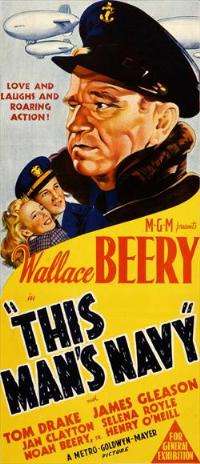This Man's Navy
This Man's Navy (aka Airship Squadron No. 4. and Lighter Than Air) is a 1945 World War II film about U.S. Navy airships directed by William A. Wellman and starring Wallace Beery, Tom Drake, Jan Clayton and James Gleason. It is one of the very few films, other than training films, to depict navy airships.[1]
| This Man's Navy | |
|---|---|
 | |
| Directed by | William A. Wellman |
| Produced by | Sam Marx |
| Written by | Borden Chase (story and screenplay) Hugh Allen (uncredited) Allen Rivkin (uncredited) John Twist(uncredited) |
| Based on | Story idea by Commander Herman E. Halland U.S. Navy (Ret.) |
| Starring | Wallace Beery Tom Drake James Gleason Jan Clayton |
| Music by | Nathaniel Shilkret |
| Cinematography | Sidney Wagner |
| Edited by | Irvine Warburton |
Production company | |
| Distributed by | Metro-Goldwyn-Mayer |
Release date |
|
Running time | 100 min. |
| Country | United States |
| Language | English |
Plot
During World War II, Chief Aviation Pilot Ned Trumpet (Wallace Beery) is in charge of a blimp at Lakehurst, New Jersey naval base. "Old Gas Bag" brags about his "son," then realizes that he will need someone to impersonate his fictional son. Trumpet finds Jess Weaver (Tom Drake), a young disabled man, arranging for an operation to fix his legs, injured in a riding accident. Afterward, Weaver goes along with the deception and soon earns his Navy wings and commission as an ensign.
While on a submarine patrol mission, Trumpet launches an unauthorized attack on a German submarine (ignoring orders sent to break off the attack), but Weaver's bomb misses and the submarine fires back, hitting the airship. Trumpet takes over the controls and sinks the submarine. Weaver faces a court-martial for disobeying orders, but Trumpet takes the blame for his actions. After Weaver is awarded the Distinguished Flying Cross, he gives the DFC ribbon to his "father." Leaving Lakehurst, Weaver gets pilot training at NAS Pensacola.
Weaver transfers to Ferry Command. While on assignment in Burma, his aircraft crashes in Japanese territory. Trumpet rushes to the rescue in an airship. Fending off Japanese soldiers, the crew pick up three survivors, the fourth being killed. They are then attacked by three fighter aircraft.
With the airship punctured and losing gas, the crew jettison as much as they can to gain altitude; when that is not enough to reach clouds to hide in, both Trumpet and Jimmy Shannon (James Gleason) parachute out.
Allied P-38 Lightnings fly to their rescue. Afterward, Trumpet and Shannon return to base in triumph. Weaver indicates that he will be returning to the lighter-than-air service at Lakehurst, to reunite with his "father."
Cast
- Wallace Beery as Ned Trumpet
- Tom Drake as Jess Weaver
- James Gleason as Jimmy Shannon
- Jan Clayton as Cathey Cortland
- Selena Royle as Maude Weaver
- Noah Beery, Sr. as Joe Hodum
- Henry O'Neill as Roger Graystone
- Steve Brodie as Tim Shannon
- George Chandler as Bert Bland
- Donald Curtis as Operations Officer
- Arthur Walsh as Cadet Rayshek
- Will Fowler as David
- Richard Crockett as "Sparks"
- Blake Edwards (uncredited)
Production
This Man's Navy was an example of Hollywood's relentless wartime efforts to portray all the fighting units of the U.S. military in a film.[2] Wallace Beery served in the U.S. Navy as a blimp commander, and on his discharge, was instrumental in convincing MGM to produce a film in tribute to his former command.[3] Beery asked for and received complete cooperation from the U.S. Navy in making This Man's Navy.[1] [N 1]
Reception
One of the typical potboilers Beery made in the 1940s, This Man's Navy received a typical reaction from critics and public alike. The New York Times dismissed the film as pleasant fare but, "...while nominally a topical adventure, the film is largely devoted to Mr. Beery disporting himself as of yore. As a rough-hewn, golden-hearted chief petty officer in the Navy's blimp service, he is scarcely different from Beery the erstwhile marine, gob, etc."[5]
Aviation film historian Michael Paris in From the Wright Brothers to Top Gun: Aviation, Nationalism, and Popular Cinema. (1995) noted that This Man's Navy hearkened back to an earlier era. Paris wrote, the film "is something of a throwback to the melodramatic style of the pre-war years and is strangely at odds with the realistic and sombre mood of Wing and a Prayer."[6]
References
Notes
- Onscreen credits for This Man's Navy include the following written acknowledgment: "This Man's Navy was made possible with the help, guidance and cooperation of Men of Lighter-Than-Air, U.S. Naval and Marine Corps. Aviation, U.S. Army Air Force, U.S. Navy Submarine Service, and Technical Supervision of Mr. Hugh Allen, Lt. Comdr. Clyde E. Schetter, U.S.N.R., Lieut. Fred M. Lloyd, U.S.N.R."[4]
Citations
- Hardwick and Schnepf 1989, p. 62.
- Koppes and Black 1987, pp. 69, 115.
- Heiser 2006, p. 74.
- "Notes: 'This Man's Navy' (1945)." TCM, 2019. Retrieved: June 23, 2019.
- " 'This Man's Navy' Stars Wallace Beery at Globe." The New York Times, April 16, 1945. Retrieved: March 30, 2011.
- Paris 1995, p. 162.
Bibliography
- Hardwick, Jack and Ed Schnepf. "A Viewer's Guide to Aviation Movies." The Making of the Great Aviation Films, General Aviation Series, Volume 2, 1989.
- Heiser, Wayne H. U.S. Naval and Marine Corps Reserve Aviation, V. I, 1916 - 1942 Chronology. McHenry, IL: Dihedral Press, 2006. ISBN 978-0-9778267-0-4.
- Koppes, Clayton R. and Gregory D. Black. Hollywood Goes to War: How Politics, Profits and Propaganda Shaped World War II Movies. New York, The Free Press, 1987. ISBN 0-02-903550-3.
- Paris, Michael. From the Wright Brothers to Top Gun: Aviation, Nationalism, and Popular Cinema. Manchester, UK: Manchester University Press, 1995. ISBN 978-0-7190-4074-0.